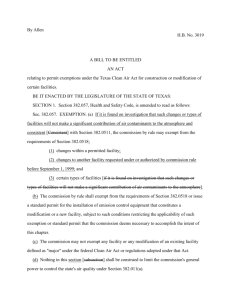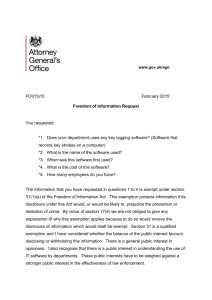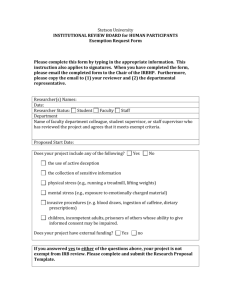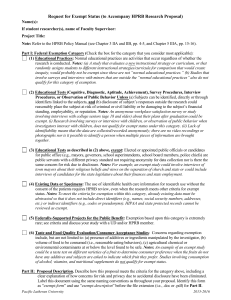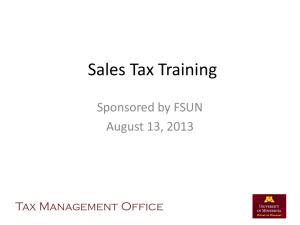Printing Industry - Minnesota Department of Revenue
advertisement
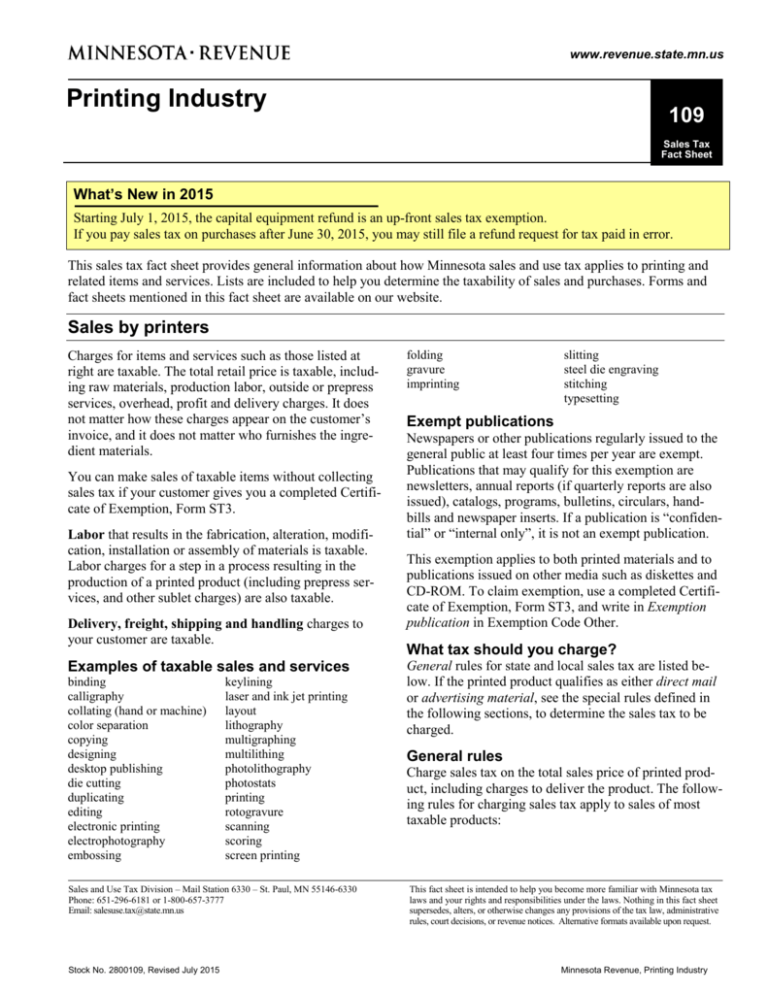
www.revenue.state.mn.us Printing Industry 109 Sales Tax Fact Sheet What’s New in 2015 Starting July 1, 2015, the capital equipment refund is an up-front sales tax exemption. If you pay sales tax on purchases after June 30, 2015, you may still file a refund request for tax paid in error. This sales tax fact sheet provides general information about how Minnesota sales and use tax applies to printing and related items and services. Lists are included to help you determine the taxability of sales and purchases. Forms and fact sheets mentioned in this fact sheet are available on our website. Sales by printers Charges for items and services such as those listed at right are taxable. The total retail price is taxable, including raw materials, production labor, outside or prepress services, overhead, profit and delivery charges. It does not matter how these charges appear on the customer’s invoice, and it does not matter who furnishes the ingredient materials. You can make sales of taxable items without collecting sales tax if your customer gives you a completed Certificate of Exemption, Form ST3. Labor that results in the fabrication, alteration, modification, installation or assembly of materials is taxable. Labor charges for a step in a process resulting in the production of a printed product (including prepress services, and other sublet charges) are also taxable. Delivery, freight, shipping and handling charges to your customer are taxable. Examples of taxable sales and services binding calligraphy collating (hand or machine) color separation copying designing desktop publishing die cutting duplicating editing electronic printing electrophotography embossing keylining laser and ink jet printing layout lithography multigraphing multilithing photolithography photostats printing rotogravure scanning scoring screen printing Sales and Use Tax Division – Mail Station 6330 – St. Paul, MN 55146-6330 Phone: 651-296-6181 or 1-800-657-3777 Email: salesuse.tax@state.mn.us Stock No. 2800109, Revised July 2015 folding gravure imprinting slitting steel die engraving stitching typesetting Exempt publications Newspapers or other publications regularly issued to the general public at least four times per year are exempt. Publications that may qualify for this exemption are newsletters, annual reports (if quarterly reports are also issued), catalogs, programs, bulletins, circulars, handbills and newspaper inserts. If a publication is “confidential” or “internal only”, it is not an exempt publication. This exemption applies to both printed materials and to publications issued on other media such as diskettes and CD-ROM. To claim exemption, use a completed Certificate of Exemption, Form ST3, and write in Exemption publication in Exemption Code Other. What tax should you charge? General rules for state and local sales tax are listed below. If the printed product qualifies as either direct mail or advertising material, see the special rules defined in the following sections, to determine the sales tax to be charged. General rules Charge sales tax on the total sales price of printed product, including charges to deliver the product. The following rules for charging sales tax apply to sales of most taxable products: This fact sheet is intended to help you become more familiar with Minnesota tax laws and your rights and responsibilities under the laws. Nothing in this fact sheet supersedes, alters, or otherwise changes any provisions of the tax law, administrative rules, court decisions, or revenue notices. Alternative formats available upon request. Minnesota Revenue, Printing Industry • When the customer picks up the printed product at the seller's location the seller charges the sales tax that applies in that taxing jurisdiction. • When the seller ships the printed product to a location at the direction of the customer, sales tax applies based on the sales tax imposed in the taxing jurisdiction where the product is delivered. • If neither 1 nor 2 applies, the seller charges sales tax based on the address they have in their records for the customer. • • Advertising materials Definition. Advertising is creative promotion. It makes you want to buy something, think positively about an idea or organization, hear about a public concern, or vote for a candidate. It promotes the sale of a product or public image. It may be a public service announcement or a political message. Charges for advertising services are not taxable if the services meet the following three criteria: • • If none of the above applies, the seller charges sales tax based on the customer's address obtained during the sale transaction such as the address on the customer's check. • there is no functional use of the product except to carry the message the seller must be involved in the creation of advertising the seller must have a direct relationship with the advertiser However, inputs to nontaxable advertising services are taxable. See Fact Sheet 133, Advertising- Creative Promotional Services, for more information. If none of the above applies and the seller does not have an address for the customer, the seller charges sales tax based on the address the printed product was shipped from. Taxable advertising. Printing is a taxable input to advertising services. The total charge, including delivery charges, is taxable unless the advertising material qualifies as direct mail described above. In addition, there is an exemption from sales tax for advertising materials that will be used outside of Minnesota. Do not charge Minnesota sales tax on the cost of advertising materials you ship outside of Minnesota for your customer. If your customer takes possession of the advertising material in Minnesota, they may claim exemption for the portion of advertising materials that they intend to ship outside of the state by giving you a completed Certificate of Exemption, Form ST3, using the “Percentage exemption” and indicating the percentage claimed as exempt. Note: In situations where the seller is not required to be registered to collect sales tax in the taxing jurisdiction where goods are delivered, it is the customer’s responsibility to report and pay any tax due directly to that taxing jurisdiction. Direct mail Definition. Direct mail is printed material that meets the three following guidelines: 1. it is delivered or distributed by U.S. Mail or other delivery service; 2. it is sent to a mass audience or to addresses on a mailing list provided by the purchaser or at the direction of the purchaser; and 3. the cost of the items is not billed directly to the recipients. Nontaxable advertising. If the printer is creating the concept and design of the advertising, rather than just set-up and printing, it may be a nontaxable advertising service. It must be clearly indicated on the customer’s invoice that the job is a nontaxable advertising service, rather than a printing job. In this case, tax is due on the input costs to the printer rather than on the sales price to the customer. Items to be included with the printed material also qualify as direct mail, if supplied by the purchaser to the direct mail seller. (For example, shampoo samples to be included with shampoo coupons.) Direct mail does not include multiple items of printed material delivered to a single address. When nontaxable advertising is to be distributed outside Minnesota, the customer should give the printer Form ST3, or any written documentation that identifies the percent of advertising used outside Minnesota. The printer owes tax only on the portion of inputs for advertising used in Minnesota. Direct mail delivery exemption. Charges for delivering or distributing direct mail are not subject to sales tax as long as the charges are separately stated on the invoice to the purchaser. Delivery charges include charges for transportation, shipping, postage, handling, crating, and packing. Because of the complexity of the sales tax advertising rule, persons may claim a full exemption when purchasing advertising inputs such as printing (Sales Tax Form ST3). The purchaser must then self-assess use tax on the taxable portion. See Fact Sheet 173, Direct Mail and Fulfillment Services, for more information and direct mail taxing rules. 2 Minnesota Revenue, Printing Industry Purchases by printers If a maintenance contract only covers repair labor, charges for the repair labor are exempt, charges for repair parts are taxable. Items used in industrial production There is an exemption for materials used or consumed in the production of printed materials that will be sold ultimately at retail. Printers can buy these materials exempt from tax by giving the seller a completed Certificate of Exemption, Form ST3. See Fact Sheet 145, Industrial Production, and 129, Utilities Used in Production, for more information. See Revenue Notices 12-12, Warranty and Maintenance Contracts and 93-03, Application for tax to the Printing Industry for more information. Computer software There are different types of maintenance agreements for computer software. For optional maintenance agreements, upgrades or enhancements are taxable; support services such as consulting or phone support are exempt. Charges for a combination of the above are taxed on 20% of the price of the maintenance agreement. See Fact Sheet 134, Computer Software for more information. Capital equipment To qualify for the capital equipment exemption, the equipment must be primarily used in Minnesota to manufacture or fabricate tangible personal property to be sold ultimately at retail. Beginning July 1, 2015, the capital equipment exemption is allowed at the time of purchase. To purchase exempt, the purchaser must give the seller a completed exemption certificate, Form ST3. Taxable purchases All purchases of office supplies, furniture, lighting, computers, printers and other equipment used for administration and record keeping, inventory control, tracking, or any use other than production are taxable. If you buy these items and the seller doesn’t charge sales tax, you must pay use tax. Before July 1, 2015, you must continue to pay the sales or use tax on all capital equipment and apply for a refund. To claim a refund on capital equipment purchases, complete a Sales and Use Tax Refund Request and Multiple Period Amended Return, Form ST11, and provide the documentation requested. How to report sales and use tax For more information, see Fact Sheet 103, Capital Equipment. Report state and local sales and use taxes electronically over the Internet at www.revenue.state.mn.us. If you don’t have Internet access, you can file by phone at 1-800-570-3329. Maintenance and warranty contracts Maintenance contracts for equipment that include repair and replacement parts and consumable items at no additional cost are taxable. Maintenance contracts for equipment used primarily to manufacture tangible personal property may qualify for the capital equipment exemption. Local sales and use taxes If you are located or working in an area with a local tax, local sales or use tax may also be due. Local taxes are listed and explained in detail in Fact Sheet 164, Local Sales and Use Taxes. Example: A maintenance contract for copy machines used for making business cards that are sold at retail qualifies for the capital equipment exemption. Beginning July 1, 2015, the maintenance contract is exempt. Before July 1, 2015, you must pay the sales tax on the contract and apply for the refund. References M. S. 297A.68, Subd. 5, Capital Equipment M. S. 297A.67, Exemptions Rule 8130.1100, Utilities and Residential Heating Fuels Rule 8130.5500, Subp. 8, Taxable Equipment Rule 8130.5500, Subp. 9, Separate Detachable Units Rule 8130.5550, Special Tooling Rule 8130.9230, Advertising Revenue Notice 12-12, Warranty and Maintenance Contracts Modification of Revenue Notice 93-03, Application of Tax to the Printing Industry Example: A maintenance contract for office copy machines where parts and consumable items such as toner, developer, drums, etc. are replaced at no additional cost is taxable. Warranty contracts act like insurance against future unexpected repair cost. Warranty contracts for equipment are generally nontaxable service charges as long as they are separately stated on the invoice. The service provider must pay sales or use tax on the cost of all parts and materials used under the contract. Other Fact Sheets 142 Sales to Governments 146 Use Tax for Businesses 164 Local Sales and Use Taxes 3 Minnesota Revenue, Printing Industry Purchases by the printing industry (starting July 1, 2015, the capital equipment exemption is allowed at the time of purchase) Composition Room Silk Screen Printing (Text Copy, Art Preparation) Items which may qualify for the capital equipment exemption Canned software Computer equipment Computer data storage equipment Diskettes, magnetic tape Foundry type (re-usable) Line-up tables, chairs, desks Linotype, intertype magazines Matrices Personal computers Phototypesetting machines and parts Press lock-up parts for metal composition Saws Type gauge T-squares, rules and composition sticks Typesetting machinery, parts (hot or cold) Items which may qualify for the capital equipment exemption Screens Frames Hand or machine rollers Squeegees Squeegee handles Blade refills Exempt Double sided tape Developing chemicals Film negatives, positives Ink Lubricating oils and greases Masking tape Phototypesetter supplies Photo display tape Process lettering Purchased author alterations Purchased composition Purchased phototypesetting Spray fixative TTS tapes Pressroom Items which may qualify for the capital equipment exemption Coating machines Drum and pail pumps Electronic printers Forklifts Hand trucks Ink curing equipment Offset duplicators Pail rack Press machinery processes, parts including: bearers calendar rolls cylinders feeders grippers guides ink fountains rollers sheet detectors Quality control equipment, instruments: control targets densitometers fadometer gauges inkometers magnifying glasses paper hygroscopes psychrometer tackoscopes Roller metal core shafts Scissors, knives, tools Shelving for work in progress Skids (paper) Viewing booths Weighing scales Platemaking (Pre-Press) Accessory Tools, Equipment and Other Short Lived Items are exempt as long as: 1. The item is a separate detachable unit. 2. It produces a direct effect on the product. 3. It has an ordinary useful life of less than 12 months. Most printing plates meet the criteria in #1 and #2. The taxability test hinges on #3. “Ordinary useful life” is measured by the length of time a plate would last if used continuously in production under the normal working conditions of the “user.” Exempt Ink Film positives Artwork Exempt Contact negatives, positives Continuous tone separations Creative art (drawings, keylines, photographs) Dot etching Halftone negatives, positives Line negatives, positives Masking tape Opaquing Proof press plates Proof processes (blue print, color key) Proof processes (cromalin, dry key, ozalid) Proof processes (photostats, poly proofs) Proof processes (silver prints, technifax) Laminated color proofs Prefilm proofs from electronic image devices Repro proofs Stripping Tape 4 Exempt Acids and glues Anti-static spray Blanket coating Blanket saver Blankets Bronze powder Custom die-cutting materials Dampener sleeves Dampening solution Disposable gloves Etch solutions Flying pasters Inks and varnishes includes: additives concentrates conditioners driers reducers toners Lubricating oil and greases Non-offset spray Padding compound Paper roller cores Paper stock PH indicator sticks Press wash (during production) Presspack Pumice powder Roller covering including molletron which has a direct effect on the product Scoring tape Splicing tape Tympans and drawsheets Minnesota Revenue, Printing Industry Graphic arts, film assembly and proofing May qualify for the capital equipment exemption Airbrushes (photography) Anti-static devices Automatic plate processor Autostripper Copyboard Control targets Densitometer Diffusion transfer system Dispensers for supply items Electronic scanning equipment and parts Electronic pre-press system and parts Film dryer equipment Film processors Film plate, proofing and stripping punch Graphic arts cameras, parts, attachments Knives and scissors Laser imaging devices: Black and white laser printers Die subs Image setters Ink jets Thermal works Light fixtures Light tables Magnifying glasses Off-press color proofing systems, parts Opti-copyer Pin register devices Parts for automated stripping Proof presses, parts Process cameras Scanners Sinks Shelving and storage Spread and chocke machine Step and repeat machines and parts T-squares Tables, desks, chairs Vacuum frames Viewing booths Whirlers Commercial art and advertising department Exempt Acids, developers, fix, chemicals Anti-halation backing Carbon tissue Color filter Color separations Contacts, duplicate prints or films Diazo coatings Electrotypes Exposure light bulbs, arcs Goldenrod paper Gum, ink, masks Litho wipes Masking tape, litho tape, scotch tape Metal toner Mylar Opaque, film, process paper Photographic materials Photopolymer coatings: Acetate Amberlith Masking materials Mylar Vinyl film carriers Vubylith Paper plates Plastic plates Proofing paper, process printing supplies Purchased paste-up and keylines Purchased stripping Repro proofs Rubber or latex gloves Scoring tape Stereotype mats, mat services Various other color proofing materials May qualify for the capital equipment exemption Air brushes Brushes Cameras, parts, attachments Dispensers for tape, ink, etc. Drawing boards Enlargers Photo processing equipment Scissors Shelving and storage T-squares Xacto knives and blades Exempt Art board Blow-ups Color matching swatch books Fixative spray Ink paste Marking pencils Paper, film, acetate, amberlith Photo prints and photostats Photographic supplies Screen tints Strip type Tape Tissue overlay Assembling, binding, mailing and shipping May qualify for the capital equipment exemption Banding machinery (not metal bands) Cheshire mailing equipment Clipboard Collators Counters Die cutting jackets Drillers Folding machines Fork lifts Glue brushes and pots Labeling plates Mullen tester Padding frames Papercutters Pressure sensitive mailing machines Staplers and dispensers Stitchers Shelving for work in progress Truck (hand) and handling equipment Weighing scales Exempt Back lining Cartons, cans and bags (non-returnable) Chipboard Labeling mats, supplies Lubricating oils and greases Metal banding Mailing materials Packaging (external, internal) Paste and glue for bindery Rubber bands Sealing tape for cartons Suction cups Signature boards Skids, pallets, tops (nonreturnable) Staples, refills Stitching, tying wire for packaging Tape used in production Wire, cord, string for packaging Wrapping paper Shrink wrap Accessory tools, equipment and other short lived items used in cutting, scoring, slitting, perforating, collating or stitching are exempt, as long as: 1. The item is a separate detachable unit. 2. It produces a direct effect on the product. 3. It has an ordinary useful life of less than 12 months. Examples that usually meet these three criteria include knives, dies, punches, cutting rules, press punches, perforating rules, blades, etc. 5 Minnesota Revenue, Printing Industry
